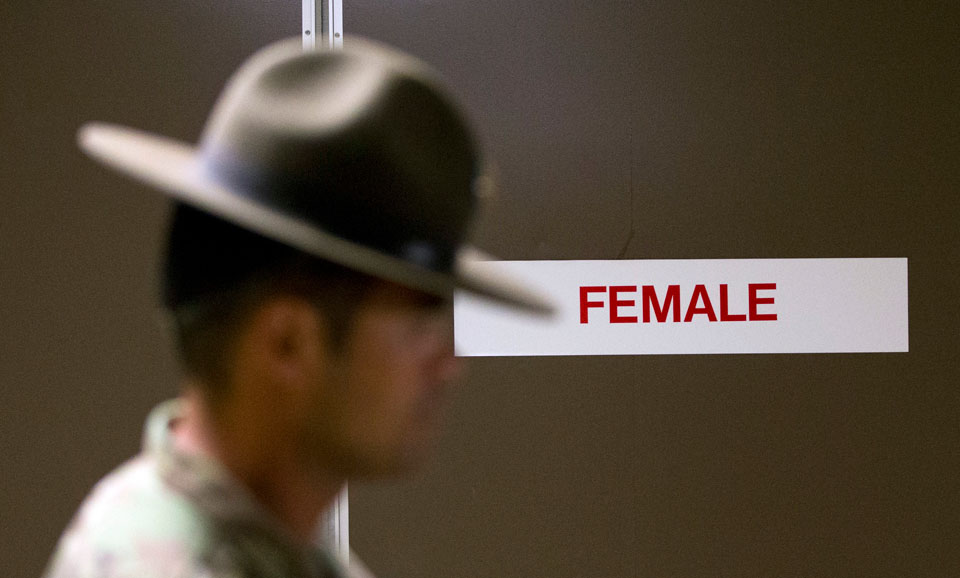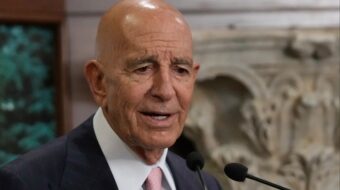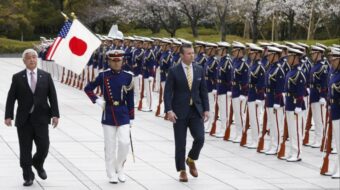
On Sept. 1, the House Armed Services Committee joined the Senate Armed Services Committee in voting 35-24 to expand registration for a possible military draft to include young women as well as young men.
Following this House committee vote and an earlier Senate committee vote in July (before Congress’s summer vacation), the versions of the annual “must-pass” National Defense Authorization Act (NDAA) to be considered later this fall in both the House and Senate will include provisions requiring women to register for the draft within 30 days of their 18th birthday and report to the Selective Service System each time they change their address until their 26th birthday, as young men have been required to do since 1980.

An alternative compromise amendment to suspend draft registration unless the president declared a national emergency and put the Selective Service System into standby was submitted before a committee session but ruled out of order on the basis of arcane PAYGO procedural rules. Under the same rules, the amendment to the NDAA to expand draft registration to women was ruled in order, considered, and adopted without any anti-war opposition from members of the committee.
Floor amendments may be proposed when the NDAA is considered by the full House and/or the Senate to repeal the Military Selective Service Act, end draft registration entirely, abolish the Selective Service System or put Selective Service into “standby” as it was from 1975 to 1980. But even if such amendments are proposed and put to a vote, they have little chance of success in either the House or the Senate.
It’s now overwhelmingly likely that the Fiscal Year 2022 NDAA to be adopted in late 2021 or early 2022 will authorize the president to order women to register for the draft at age 18, starting in 2023 with women born in 2005 and after.
Shifting the focus from Congressional lobbying to resistance
In the most obvious sense, the attempt to get young women to register for the draft and report changes of address to the Selective Service System is bound to fail in practice. Few young men comply with the registration and address reporting requirements, and even fewer young women are likely to do so. Widespread noncompliance has rendered registration of men unenforceable, and the proposed legislation to expand draft registration to women includes no plan or budget for enforcement.
Women have all the same reasons to oppose the draft as men do, plus additional reasons of their own. As I pointed out in my testimony in 2019 to the National Commission on Military, National, and Public Service (which invited no draft-age women to testify about whether they should or could be forced to register), “Both feminist and anti-feminist women will be more likely to resist being forced into the military than men have been, and more people will support them in their resistance. There’s a long tradition of anti-war feminism that identifies militarism and war with patriarchy. Women have been an important part of draft resistance movements even when only men were being drafted and when most public attention has been on male resisters.”
Now the tables are turned. It’s time for men to support young women in their resistance to the expansion of draft registration, just as it’s time for older people to support young people as allies in their resistance to an age-based draft.
But if expanding draft registration to women is bound to fail, if draft registration is already unenforceable and has been so for decades, if an attempt to bring back the draft is unlikely, and if the registration database would be less than useless (in the opinion of a former Director of the Selective Service System) for an actual draft, why should we care about draft registration or make it a priority to support draft registration resistance?
The flaw in the thinking behind this question is the mistaken assumption that the primary goal of anti-draft activism is to protect young people from being drafted.
It should go without saying—but unfortunately doesn’t get said—that the primary victims of a U.S. draft are not the draftees themselves, but the much larger numbers of people, mainly civilians, against whom draftees are deployed to wage war around the world, and the civilians at home, especially women and children, who are impacted by the violent masculinity in which soldiers are trained. That this is not clearly understood, and that draftees are conceptualized primarily as passive victims of the draft rather than as potentially empowered agents of obstruction of the war machine, is symptomatic of the ageism of most observers, even otherwise progressive ones. The ageist conceptualization of young people as passive “victims” of the draft denies them agency and blinds older people to the success of their nonviolent noncooperation with a system that seeks not only to oppress them but to use them to oppress others.
Since 1980, resistance to draft registration has won a profound victory over the state and the war machine: It has rendered draft registration unenforceable and prevented a draft.
But that victory is only partial. The function of draft registration is not so much to enable an actual draft as to enable war planners to pretend that the draft is a viable policy option so that they can contemplate and commit the U.S. to larger, longer, less popular wars without having to consider whether enough people will volunteer to fight them. The real victory of draft resistance will be when the failure of draft registration and the consequent unavailability of a draft as a military “fallback” option is widely enough recognized that U.S. war planning and war making begin to be constrained accordingly.
The failure of older allies to publicize and follow through on the success of draft registration resistance in preventing a draft, and thereby to realize the potential of that resistance to rein in military planning and adventurism, can be directly attributable to their overt or unconscious ageism.

Misconceiving their goal from the start as protecting vulnerable (read: powerless) young people from the draft rather than helping young people protect the world from wars that depend on young people as warriors, ageist anti-draft activists have assumed that as long as the threat of a draft has been eliminated, there is no further need or reason for anti-draft activism. As a result, many of them redirected their energy and their priorities for activism away from the issue of the draft, just when the success of draft registration resistance had brought it to the brink of a larger victory over planning and preparation for unlimited war(s).
Since the government has not yet been forced to admit that draft registration has failed, it has continued to plan and initiate one war after another on the assumption that, if it needs to do so, it can always fall back on a draft.
Draft resistance is not a lobbying strategy but a tactic of nonviolent direct action. Its success does not depend on Congress. Just the reverse: the government’s ability to wage war depends on the willingness of (young) people to fight. Young people have the power to prevent wars by opting not to fight them—and now young women are about to be given that power as well.
Is this a “feminist” issue? Yes, insofar as women may now be spurred into greater action against war-making under the threat that they may themselves be inducted into the military maw. But insofar as the draft authorizes even more American women than presently to shoulder the burden of killing, maiming, bombing, strafing, poisoning other women, children, elders, boys, and men any place in the world they are sent to do so, and for any reason, it is decidedly not!
As Congress moves toward a vote to expand draft registration to young women as well as young men, it’s time to support all young people in their resistance and to educate, agitate, and organize against the draft and draft registration.
Edward Hasbrouck maintains the Resisters.info website and publishes the “Resistance News” newsletter. He was imprisoned in 1983-1984 for organizing resistance to draft registration.










